1Department of Marketing, Sumy State University, Sumy, Ukraine
2Department of Business Economics and Administration, Sumy State Pedagogical University named after Makarenko, Sumy, Ukraine
Corresponding author Email: n.letunovska@gmail.com
Article Publishing History
Received: 22/07/2019
Accepted After Revision: 27/09/2019
Current economic and social development of world regions, especially the territories of former USSR countries needs using modern technologies such as marketing of changes, innovative approaches to regional infrastructure development. Successful combination of different instruments together with adequate evaluation of their effectiveness impetus for the introduction of positive changes in the regions’position. The authors of the study developed the method for evaluating the potential of regional infrastructure with the formation of an integral indicator with four directions. The scientific novelty of the research is to substantiate the proposals for formulating an approach to assessing the effectiveness of regional infrastructure. The methodological coherence of the evaluation of indicators, unlike their separate analysis, greatly expands the possibility of objectively calculating the synergistic effect of the functioning of different infrastructure activities as components of the system. The totality of evaluations within the framework of the author’s methodology makes it possible for qualitative comprehensive evaluation, adherence to the principles of hierarchy, complexity and universality of the evaluated criteria. The practical significance of the obtained results is the ability to use the results of this study in the practical activities of the entity managing territories that are aimed at providing socially significant services to the population. The proposals of the authors will be useful to the regional authorities in developing measures to enhance the development of local infrastructure as well as in the management of private social institutions.
Infrastructure, Infrastructure efficiency, Innovation, Marketing of changes, Regional development.
Teletov A, Letunovska N, Melnyk Y. Four-vector Efficiency of Infrastructure in the System of Providing Regional Socially Significant Needs Taking into Account the Concept of Marketing of Changes. Biosc.Biotech.Res.Comm. 2019;12(3).
Teletov A, Letunovska N, Melnyk Y. Four-vector Efficiency of Infrastructure in the System of Providing Regional Socially Significant Needs Taking into Account the Concept of Marketing of Changes. Biosc.Biotech.Res.Comm. 2019;12(3). Available from: https://bit.ly/2l5lgsZ
Copyright © Teletov et al., This is an open access article distributed under the terms of the Creative Commons Attribution License (CC-BY) https://creativecommns.org/licenses/by/4.0/, which permits unrestricted use distribution and reproduction in any medium, provide the original author and source are credited.
Introduction
Regional innovation systems formation, creation of targeted programs and projects concerning local social and economic development, marketing of changes implementation in local infrastructure objects management are tasks that require innovative approaches to their realization. It should be borne in mind that every innovative solution in the system of regional governance have both economic and social consequences, which necessitates perfect scientific and practical forecasting of the innovative marketing tools effectiveness. In modern conditions regional territorial policy should be based on the cooperation of state, private and local business infrastructure on the basis of their common goals. At present, the issue of innovation management and marketing of innovations, in particular in the regions activity, has been thoroughly researched in domestic economic science (Fedulova, 2015, Kainova, 2014, Lyulov, 2019, Oliinyk 2017, Orlatyi et al, 2013, Pepchuk, 2015, Poliakova, 2016, Prokopenko, 2017, Syhyda, 2018, Vasylieva, 2018, Goltvenko et al, 2019), as well as in the work of foreign scientists (Uyarra, 2010 Schwerdtner, 2015, Huang, 2013, Kolehmainen, 2016, Eder, 2017, Fridman, 2017). However, the subject of regional innovation management, in particular in the area of infrastructure provision of territories, remains poorly developed.
There is a clear tendency to intensifying the competition between regions, cities and territories for financial and information flows, highly qualified specialists, investors. Competitive bases for receiving funds from the state budget for the implementation of local projects are being implemented. More and more territorial units are developing projects and submitting them to competitions. Such competitive atmosphere forces territories to compare themselves with others, determine what they are best at, and demonstrate these benefits in the region’s innovative passport. The use of marketing technologies for regional development is a new phenomenon for Ukraine, but the need for them is increasing. The authors highlight the main factors of social progress in modern conditions, Figure 1.
 |
Figure 1: Factors of social progress |
The figure purposely combines factors of social development socialization and information revolution, which on the one hand are influenced by scientific and technological progress as a separate fundamental factor of changes in society and the emerging factor of marketing of changes, the use of which causes changes in the parametric factors of socialization (social changes which are driven by the influence of marketing tools) and on the other hand by information revolution (revitalizing the progress of the information component due to the impetus of active marketing tools implementation to manage the process of social development). Marketing tools are a solid foundation for streamlining strategic decision-making to build a positive image of countries and regions, enhancing their competitiveness. The infrastructure of the region is one of the dominant parameters that affects the reproduction potential of the territory, improving the quality of life, branding and more. In order to formulate appropriate priorities for the infrastructure development, it is advisable to develop criteria that will determine its current effectiveness and criteria of changes (strategic benchmarks that determine the further development of each infrastructure institution, regardless of its subordination). By aggregate estimates of each infrastructure item, it is possible to form a general map of the infrastructure provision of a particular region. An integrated assessment of the infrastructure development provides an opportunity to rank individual regions in terms of their infrastructure security, taking into account the impact of each type of institution on the social and economic situation of each region.
On the basis of determining the current state of infrastructure development level with the accession of foresight, it is possible to predict possible structural and dynamic changes in infrastructure development in the future. The consolidated assessment methodology makes it appropriate to compare the development of the infrastructure of a particular territory with the same assessments of it in the country as a whole.The level of regional development is determined by a number of aggregated, generalized and isolated indicators. Human Development Index has a fundamental role when calculating the countries’ competitiveness. According to this indicator, Ukraine is in rather low positions – its value is lower than the average for the countries with high index of human development and below the average for the countries of Europe and Central Asia. In the period from 1990 to 2014, the value of the Human Development Index in Ukraine increased slightly from 0.705 to 0.747, but only by 6%, which is below the average level of its growth in the world (Chela, 2017).
The dynamics of this indicator in recent years is presented in Figure 2. In general, we can note the unstable dynamics of this indicator.
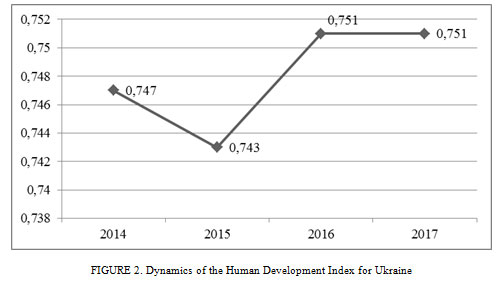 |
Figure 2: Dynamics of the Human Development Index for Ukraine |
The Human Development Index is directly related to the well-being of the population, which is also determined by the level of infrastructure development. Employee security with all the necessary social components through the use of social assets, is determined by the “decent work” in the figure below.
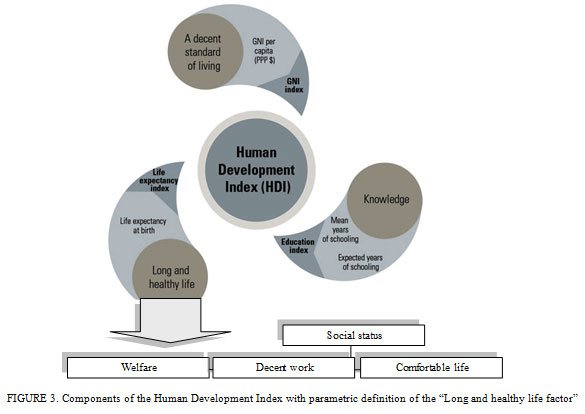 |
Figure 3: Components of the Human Development Index with parametric definition of the “Long and healthy life factor” |
There are a number of useful projects implemented in Ukraine related to the infrastructure provision of regions. The first open source portal for local communities, GIS DATA, has been initiated and implemented to help decision-makers in various projects plan their follow-up more effectively. The tools of this portal allow to manage the network of infrastructure in each territory. Considering that 40% of school buildings in Ukraine are unfit for pupils’ education, the urgent effective infrastructure solutions are badly needed. In the area of consumer services, there is a decline in the number of objects and the share of services provided to the public, although almost two thirds of all services are owned by private companies. In the trade and restaurant industry, there is a steady decline in retailers, especially in rural areas. There is a decline in restaurant network while increasing the fast service facilities. This is despite the fact that these are the objects of vital importance in the sphere of hospitality, which is identified as promising in Ukraine. The territorial accessibility of social infrastructure is, in fact, a criterion for optimizing the location of these objects and the effectiveness of their territorial organization. The average radius of social infrastructure accessibility in Ukraine is 5.7 km, with its highest mark 8.0 km in Kherson region and the smallest value 1.4 km in Kyiv. The range of accessibility of social infrastructure in Ukraine is permanently increasing (Shpyliova, 2006). Moreover Ukraine is characterized by a significant disproportion between housing and social infrastructure in cities. The dynamics of the obtained permits and the number of construction objects indicate that the pace of housing construction in Ukraine will not fall in the nearest future (Zaderei, 2019).
The industry is attractive to investors, as evidenced by the announcements of major projects. A study of Ukrainian households (Novikov, 2018) on the availability of individual goods and services shows that a lot of urban and rural households are deprived of their social needs, such as personal development, quality rest, medical care. A number of other problems with the accessibility of social services can be observed among the rural population.
Table 1: Survey results of Ukrainian households assessing their availability of infrastructure services (fragment)
| Signs of unavailability of social services | Percentage of households deprived of goods and services, % | |
| urban | rural | |
| Lack of funds to pay for the services of a doctor in a medical institution (in the absence of such services on a free basis), analyzes, examinations, procedures | 27.4 | 31.3 |
| Insufficient funds to pay for inpatient treatment services (in the absence of such services on a free basis) | 26.6 | 32.0 |
| Insufficient funds for vocational education | 7.2 | 8.7 |
| The impossibility of a family vacation not at home for at least one week a year | 52 | 52.0 |
| Absence of retail stores near housing | 2.9 | 13.7 |
| Absence of establishments providing domestic services (hairdressing salons, dry-cleaners, repair of clothes, etc.) | 5.6 | 51.5 |
| Absence of pre-school facilities near housing | 1.3 | 4.6 |
The building norms of Ukraine state that the infrastructure of the city needs to be developed with the increase of population both in large and peripheral cities. However, the inconsistency of some provisions allows developers to circumvent such requirements. According to Article 40 of the Law of Ukraine “On Regulation of Urban Planning Activity”, construction companies are obliged to pay a share contribution to the construction of infrastructure before the commissioning of the facility to the limit of up to 4% of the estimated cost of the project. Developers can make this contribution with money or in the form of utilities, kindergarten, school or other infrastructure objects. Therefore, often construction companies include educational institutions in the plans for construction of large residential complexes. Multiple companies can combine and build schools and kindergartens with spot-building in one array. Developers explain that they are ready to create local social infrastructure at the expense of a share contribution, but the city does not always accept on its balance built educational institutions, so new residential complexes often open private kindergartens and schools. This helps companies improve their reputation and make their assets more attractive to investors. In addition, there have been attempts to cancel even such a share contribution to the development of local infrastructure, which is explained by the lack of such practices abroad, the deterioration of the Doing Business ranking in terms of increasing the cost of administrative procedures, the lack of unit participation for the repair of infrastructure objects. From 2017 the sanitary norm “Equipment, maintenance of preschool educational institutions and organization of children’s life” ceased to operate in Ukraine.
This document set out the requirements for the permissible walking distance for kindergartens. Instead, the Sanitary Regulations for Preschool Institutions entered into force, in which these requirements are absent. This means that it is no longer regulated how many kindergartens should be built in a particular settlement. Many decisions to be made do not go in favor of local infrastructure. At the beginning of the twentieth century many social needs including medical, cultural, professional, etc., have traditionally provided by regional town-forming enterprises for their employees and their families through their own infrastructure network (sanatoriums, medical centers at the enterprise, recreation centers, children’s camps, vocational training, etc.). Currently, there is only a small proportion of infrastructure assets in very poor condition remains. They have potential utility and effectiveness for the enterprise if to manage them adequately (Sager, 2014).The authors of this study have attempted to evaluate the potential of regional infrastructure with the formation of an integral indicator, which can be included in the system of general indicators for assessing the level of social and economic development of regional systems.
Material and Methods
This research was carried out based on an integrative review methodology where relevant articles based on the research scope with key words such as infrastructure, regional infrastructure, infrastructure assessment, and infrastructure development were used (Kyrychenko, 2016, Sadchikova, 2017, Panasiuk, 2012, Malchykova, 2016). Such integrative review methodology allows to outline relevant papers both past and present for review in other to give better understanding to the topic of local infrastructure assessment from the standpoint of its development.
Results and Discussion
Infrastructure efficiency is proposed to be evaluated in four components: economic, image, social and developmental capacity. The last component takes into account principles of marketing of changes. These components form the multiplicative efficiency of regional infrastructure, Figure 4.
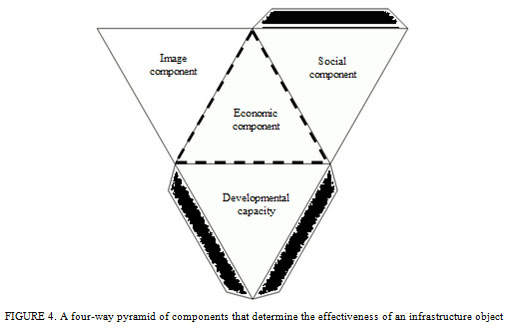 |
Figure 4: A four-way pyramid of components that determine the effectiveness of an infrastructure object |
The generalized model for evaluating infrastructure effectiveness is as follows:
Einfr. = {Се; Сi; Сs; Сd.c.} (1)
where Еinfr. – four-dimensional indicator of infrastructure effectiveness; Се – economic component; Сi – image component; Сs – social component; Сd.c. – component of developmental capacity.
The economic component includes profitability indicators, which give information on whether a particular infrastructure item is profitable. The image component is manifested in the active support by the local population, the frequency of citizens visit, priority of their development in the eyes of the local population. The social component is to provide society with a set of services especially those services that are the most needed due to the lack of them in a particular region. The state of the material and technical base is a significant factor of competitiveness for the institutions of cultural and public services. This is the main factor that attracts consumers. Therefore, the analysis of indicators such as deterioration coefficient and replacement coefficient must be taken into account in the economic component of performance analysis.
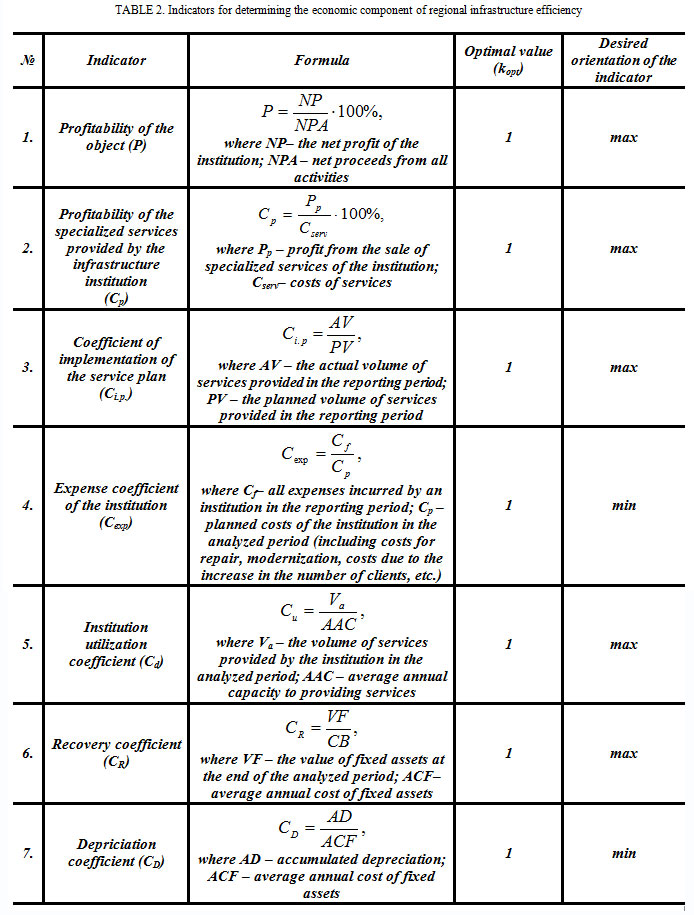 |
Table 2: Indicators for determining the economic component of regional infrastructure efficiency |
The next step is to build a model for calculating the integral index of the economic component. To calculate the integral metric based on the above indicators, we propose to use the universal metric – Harrington’s desirability function, which is characterized by such properties as adequacy and statistical sensitivity, which allows it to be used as an optimization criterion. The basis for constructing this generalized function is the idea of converting the natural values of individual indicators into dimensionless form, with the following subtraction of partial functions on the Harrington scale and the integral index of economic component E:

where n – the number of indicators used to evaluate the economic component of an institution’s efficiency; di – partial function that is determined according to the Harrington scale; yi – economic component in dimensionless form.
In order to use the Harrington scale, it is necessary to transfer the studied indices to a dimensionless form and to calculate the values of partial functions by formula (3).
We use such formulas to give dimensionless form to the indicators:

where ki – the estimated value of the indicator; kopt – the critical value of the indicator; max/min – criterion of maximization (minimization) of the indicator. To characterize the level of economic component of a particular institution of infrastructure we will use the scale given in Table. 3.
Table 3: Standard marks on the Harrington scale
| Function value | Marks on the scale |
| 1.00-0.81 | Very good (excellent) |
| 0.80-0.64 | Good |
| 0.63-0.38 | Satisfactory |
| 0.37-0.21 | Bad |
| 0.20-0.00 | Very bad (critical) |
The image component involves the study of the consumers’ attitude to infrastructure services, which is expressed in the frequency of requests for services, as well as the desire of clients to recommend the institution to other people. In this component it is expedient to take into account such criteria as the convenience of receiving services, the adequacy of the premises of institution, the facilities, the level of service, the openness and accessibility of information about institution, the variability of services, etc. The image of infrastructure objects is often determined by the small details. It should be convenient for the local population to receive the service of institution. An important role has the lack of queue, simplicity of registration and so on. Regarding the adequacy of the premises, this is a subjective criterion according to the opinion of the clients of institution, although for all infrastructure objects there are very specific normalized indicators of the area sufficiency. The variability of services (the ability to choose an alternative offer from an institution) is essential. Determining the quality of service indicator makes it possible to adjust the conditions of their provision and the attitude of consumers towards them. Indicator of consumer confidence in the institution is determined by the formula:
IT = ІS+ND+NA, (6)
where IT – the indicator of trust; ІS – index of satisfaction with services, which is determined by the formula (6); ND – the number of customers who have expressed a desire to use the services again; NA – the number of service consumers who are willing to advise them to other people.
![]()
where Ntotal – the total number of analyzed consumers; Nn.s. – the number of customers who are dissatisfied with the services.
The indicators in formulas (6-7) can be conveniently determined by interviewing consumers directly after the end of the service period and by the number of complaints and positive feedback received from customers.
Other quantitative indicators that determine the image component of infrastructure facilities include the following:

where Sp – the proportion of regular customers among the users of institution; RC – the number of repeat consumers (users of infrastructure services who have used service of a particular institution more than once); TN – total number of consumers of institution’s services.
This indicator looks similar to the one calculated in formula (5), but in fact the indicators differ because formula (6) shows only the desire of consumers to use the services again, and the indicator of formula (8) shows the number of consumers who have already used the institution’s services again

where Іg – index of the number of regular clients growth compared to the previous analyzed period; RCc – the number of regular customers in the current period; RCp – the number of regular customers in the previous period.
The social component of infrastructure efficiency is determined by the indicators which are shown in Table 4.
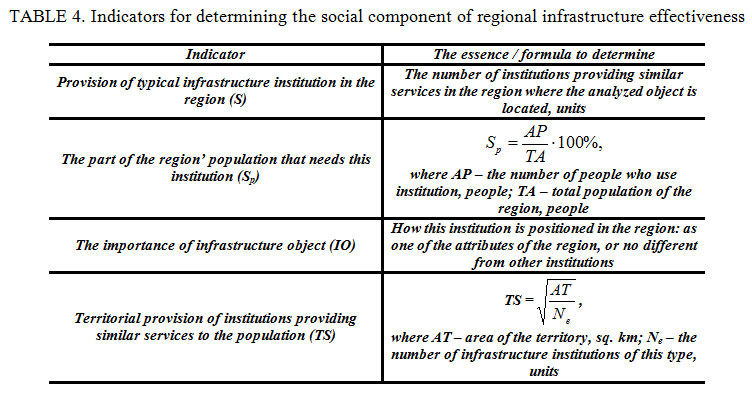 |
Table 4: Indicators for determining the social component of regional infrastructure effectiveness |
Regarding the development ability component, it can be assessed on a set of criteria expertly on a 5-point scale (0 points – institution does not meet the defined criterion; 1 point –institution is very poorly meets this criterion; 2 points – institution does not meet the specified criterion; 3 points – institution fits well with the selected criterion; 4 points – institution very well fits the defined criterion; 5 points – infrastructure object fully meets this criterion). The indicators are estimated by the formula:

where R – the readiness of institution management to implement development measures; Wi – the weight of the i-th criterion for assessing readiness for changes; Ві – evaluation of the i-th criterion in points.
The level of readiness for changes can be determined on a scale of 0 to 5 in a step determined by the formula:
SS = (Bmax – Bmin) / n, (11)
where SS – step scale; Bmax – maximum scale score; Bmin – minimum scale score; n – number of intervals.
The list of criteria for evaluating the component of readiness for development is shown in Figure 5.
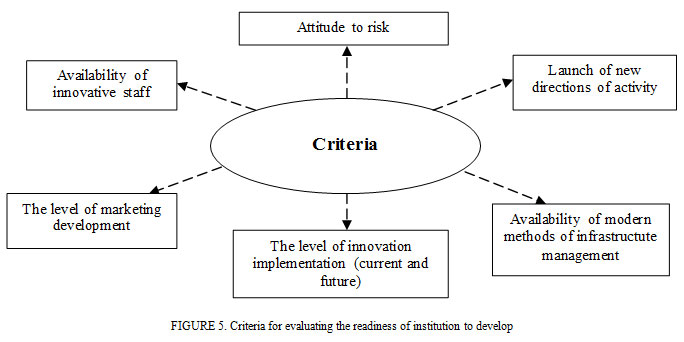 |
Figure 5: Criteria for evaluating the readiness of institution to develop |
To determine the multiplicative indicator of the effectiveness of each infrastructure institution, it is advisable to use a complex formula:

where Eа – multiplicative efficiency of infrastructure institution; Е – value of the component of economic efficiency; S – the value of the social component; І – he value of the image component; A – he value of a component of developmental ability; we – the weight of the component of economic efficiency; wS – the weight of the social component; wI – the weight of the image component; wA – the weight of a component of developmental ability.It is possible to distinguish the value of the multiplicative indicator, within which we can state the effectiveness or inefficiency of a particular infrastructure institution.
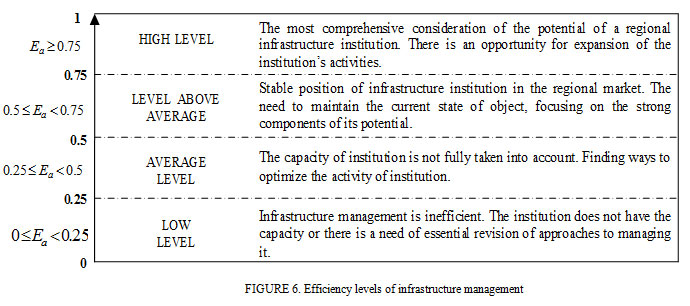 |
Figure 6: Efficiency levels of infrastructure management |
The authors’ approach to assessing an individual institution of infrastructure over four different components can be the basis for determining a comprehensive indicator of the effectiveness of regional infrastructure in certain territories. The effectiveness criteria may be revised and supplemented or modified according to specific motives of infrastructure development in the regions.
Conclusion
The scientific novelty of the research is to substantiate the proposals for formulating an approach to assessing the effectiveness of regional infrastructure. The article presents an approach to assessing the effectiveness of infrastructure institutions. The methodological coherence of the evaluation of indicators, unlike their separate analysis, greatly expands the possibility of objectively calculating the synergistic effect of the functioning of different infrastructure activities as components of the system. The totality of evaluations within the framework of the author’s methodology makes it possible for qualitative comprehensive evaluation, adherence to the principles of hierarchy, complexity and universality of the evaluated criteria. The practical significance of the obtained results is the ability to use the results of this study in the practical activities of the entity managing territories that are aimed at providing socially significant services to the population. The proposals of the authors will be useful to the regional authorities in developing measures to enhance the development of local infrastructure. Further research requires development of proposals for profiling of the estimated indicators, taking into account the specific activity of infrastructure objects, as well as focusing on the study of the conditions of direct competitors’ activity of local state infrastructure institutions – private institutions providing socially significant services to the population.
Acknowledgements
The publication contains the results of research conducted within the framework of the R&D “Forsyth forecasting of the sustainability of the national economy: from socio-ecological and economic contradictions to a convergent model” (No. 0117U003932).
References
Chela, B. (2017). Human Development Index: Ukraine is falling for what to do’. Retrieved from https://www.epravda.com.ua/columns/2017/04/13/623821/.
Eder, L., Filimonova, I., Provornaya, I. et al. (2017). Regional smart specializations in fostering innovation development of resource regions of Russia 17th International Multidisciplinary Scientific Geo Conference SGEM 2017. Environmental economics (Bulgaria, 2017): Conference Proceedings.
Fedulova, L. (2015). Innovative development of Ukraine’s economy. Herald of KNUTE, 6, pp. 28-41.
Fridman, Yu., Rechko, G., & Pimonov, A. (2017). Competitive positions of a region in innovative economic development. Regional Research of Russia, 7(4), pp. 333-341.
Goltvenko, L., & Marova, S. (2019). Ways of management of innovative development of primary territories as socio-ecological and economic systems Investment: practice and experience, 5, pp. 80-84.
Huang, B, & Zhang, T. (2013). Discussion on innovative development policies for underdevelopment regions from the p Perspective of regional innovative economy Applied Mechanics and Materials, 448-453, pp. 4049-4054.
Kainova, T. (2014). Marketing of the region as a factor of innovative development. Academic review, 2(41), pp. 85-90.
Kolehmainen, J., Irvine J., Stewart L. et al. (2016). Quadruple Helix, Innovation and the Knowledge-Based Development: Lessons from Remote, Rural and Less-Favoured Regions. Journal of the Knowledge Economy, 7(1), pp. 23-42.
Kyrychenko, S. (2016). The substantiation of indicators’ definition for assessing the development of social infrastructure in the regions. Investment: practice and experience, 6, pp. 66-70.
Lyulov, O., Bilan, Yu., Vasilyeva, T. et al. (2019). EU vector of Ukraine development: linking between macroeconomic stability and social progress’. International Journal of Business and Society, 20(2), pp. 433-450.
Malchykova, D., Korobov, V., & Sarkisov, A. (2016). Integral index in the evaluating of the infrastructure in the region development: the scientific and educational-methodical aspects’. Scientific Bulletin of Kherson State University, 5, pp. 24-30.
Novikov, V., Dieieva, N., Gvelesiani, A. et al. (2018). Social infrastructure on ways of reforming local self-government’. Kyiv-Varshava.
Oliinyk, L. (2017). Management of an enterprise innovative development on the basis of innovative programs formation’. Economics and management of organization, 3(27), pp. 51-59.
Orlatyi, M., Vakulenko M. & Berdanova, O. (2013). Substantiation of theoretical and methodological and practical aspects of innovative approaches to regional management and development’.
Panasiuk, V. & Bakum, I. (2017). The efficiency of development of the social infrastructure of region with orientation on its priority’. Business Inform, 12. pp. 144-147.
Pepchuk, S. (2015). Marketings innovations in ideology of socio-economic development of regions’. Scientific Bulletin of Kherson State University, 10(3), pp. 118-121.
Poliakova, Yu. (2016). Innovative potential of Ukraine regions. Scientific Bulletin of Uzhgorod National University, 6(2), pp. 168-171.
Prokopenko, O., Shkola, V., Shcherbachenko, V. (ed.). (2017). ‘Management of the innovative component of economic security’. TOV “Trytoriia”.
Sadchikova, I., & Koval, M. (2017). Infrastructure of the regions of Ukraine. Modernization priorities. NGO Polissya Fund for International and Regional Studies, Foundation the name of Friedrich Ebert.
Sager, L. (2014). Place of the internal communications in the industrial enterprises common functioning system’. Marketing and Management of Innovations, 2, pp. 241-249.
Schwerdtner, W., Siebert R., Busse M. et al. (2015). Regional Open Innovation Road mapping: A New Framework for Innovation-Based Regional Development. Sustainability, 7(3), pp. 2301-2321. https://doi.org/10.3390/su7032301.
Shpyliova, Y. (2006). Major ways of development and distribution of social infrastructure under the transitional economy conditions’. Dissertation for the degree of the candidate of economic sciences on the specialty 08.10.01 – distribution of productive forces and regional economics. Council for Study of Productive Forces of Ukraine of the NAS of Ukraine, Kyiv.
Syhyda, L. (2018, May). Leading innovation development and the role of non-technological innovation: Topical Issues and Prospects for Ukraine’s Development in Management and Administration’. Youth Initiatives, Internet Conference of Kharkiv State University of Food and Trade (pp. 418-419).
Uyarra, E., & Flanagan, K. (2010) From regional systems of innovation to regions as innovation policy spaces. Environment and Planning C: Government and Policy, 28(4), pp. 681-695. https://doi.org/10.1068/c0961.
Vasylieva, T., Harust, Yu., Vynnychenko, N. et al. (2018). Optimization of the financial decentralization level as an instrument for the country’s innovative economic development regulation’. Marketing and Management of Innovations, 4, pp. 381-390.
Zaderei, N. (2019). Prices are rising but housing is high. What happens to the real estate market?’ Retrieved from https://www.epravda.com.ua/publications/2019/07/2/649245/.


